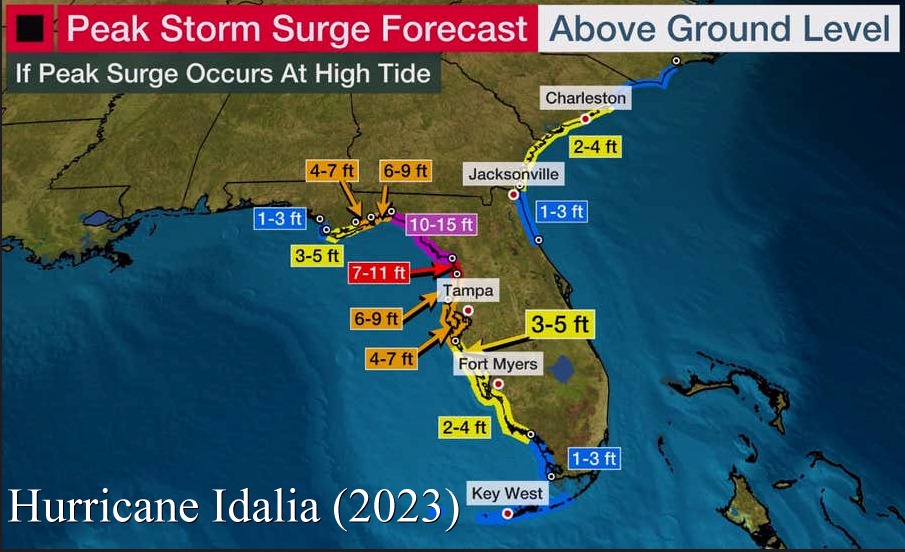January 1, 2024
In general, the shorelines and waterways that are seeing the largest storm surges are the same areas that are experiencing the fastest rate of sea level rise. The sea level does not rise at the same rate along most coasts. Some of the conditions that determine the relative sea level at any given location include: water temperature (thermal expansion), circulation, ocean floor contour, ice melt, ocean dynamics, and Earth's uneven gravity field.
The Shape of Things to Come
For the foreseeable future, storm surges will offer a good forecast of future sea level rise. Hurricane Idalia's storm surge (pictured / 2023), brought a 10-15 storm surge to the northern coast of Florida. In 2022, Hurricane Ida brought a 14-20 foot storm surge to the southern coast of Florida. Ida also made landfall in Southeastern USA. Plaquemines Parish on the east bank of the Mississippi River had an estimated storm surge of at least 14 feet. Grand Isle, Louisiana, which was located just east of a landfall, was struck by 10.2 feet and rendered uninhabitable after the storm.
We know these areas of the United States will see sea levels rise at least 10-15 feet because it has already happened. Although it was only for hours, you wouldn't want to live there during those hours. Not to mention, the frequency of these extreme weather events is rising exponentially. Thus, our recommendation to evacuate Florida now (i.e. Managed Retreat). The billions of dollars spent to rebuild after Hurricane Ida will all be for naught. Allowing building will needlessly endanger property and lives. Parts of the world have already seen storm surges of 40 feet. I expect most North American coastlines will see sea levels rise, if only temporarily, by 20-40 feet this century. Within a generation, these areas could be submerged most of the time.
Don't Be Fooled by Relative Variations
The level of the oceans is rising; however, some climate change deniers may try to claim the sea level is receding. Yes, in some instances certain areas will see a decline in the relative sea level.
In the paper, Sea level and global ice volumes from the Last Glacial Maximum to the Holocene, Kurt Lambeck states,
"The major cause of sea-level change during ice ages is the exchange of water between ice and ocean and the planet's dynamic response to the changing surface load."
As ice melt accelerates, gravity and glacial isostatic adjustment will have a greater impact on where the sea level rises the most. Greenland is a good example. Greenland has one of the largest land ice sheets. You might think the sea would rise the fastest closest to the melt. Not necessarily. "Greenland is like a bowl with large cracks in its sides." The huge ice mass has sunk the ground, as well as, added a huge mass on top of it. Much of Greenland's ice melt is just kind-of hanging out in the bowl. Two things are happening to change that: 1) As the ice mass melts, it exerts less gravitational pull on the surrounding water and the water gets pulled away. 2) At the same time, the Earth is rebounding under the bowl as the mass moves away. Much will depend on the extent and speed of the rebound. Though we don't know how fast the rebound will happen, NASA has a satellite program gathering better data by measuring the gravitational pull on the satellite (GRACE Tellus Gravity Recovery & Climate Experiment).
At the same time that Greenland is "rising" out of the sea, many cities are sinking. Alexandria, Amsterdam, Bangkok, Charleston, Miami, New Orleans, New York, Chicago, and Norfolk are all "caving in." Houston is the 10th-fastest sinking city in the world, and the U.S. city sinking the fastest.
As the ice melts off Greenland, sea level will rise around Antarctica and drop around Greenland, and as the ice melts in Antarctica, the sea will rise around Greenland and drop around Antarctica. In general, sea levels fall where the ice is melting and rise on the other side of the world. A study published in Geophysical Research Letters of the American Geophysical Union found global warming has led to significant melting of glaciers causing the planet's axis to move faster and days to grow shorter. Though there is a small effect on Earth's rotation and polar direction, it is not enough to worry about.
Measuring Sea Level Rise
So, one of the biggest questions in the future is how do you measure sea level rise? From where the land was pre-industrial, where the land is today, or where the land is tomorrow? In any event, the Earth crossed tipping points which make extreme sea level rise inevitable and irreversible. Planners should plan on it.
Sidd reiterated, "That 270 feet of sea level rise will take a long time. I would be more careful about the violent rain than the ice melt."
